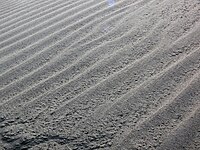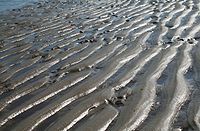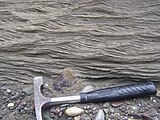Ripple marks

In geology, ripple marks are sedimentary structures (i.e., bedforms of the lower flow regime) and indicate agitation by water (current or waves) or wind.
Defining ripple cross-laminae and asymmetric ripples[]
- Current ripple marks, unidirectional ripples, or asymmetrical ripple marks are asymmetrical in profile, with a gentle up-current slope and a steeper down-current slope. The down-current slope is the angle of repose, which depends on the shape of the sediment. These commonly form in fluvial and aeolian depositional environments, and are a signifier of the lower part of the Lower Flow Regime.
- Ripple cross-laminae forms when deposition takes place during migration of current or wave ripples. A series of cross-laminae are produced by superimposing migrating ripples. The ripples form lateral to one another, such that the crests of vertically succeeding laminae are out of phase and appear to be advancing upslope. This process results in cross-bedded units that have the general appearance of waves in outcrop sections cut normal to the wave crests. In sections with other orientations, the laminae may appear horizontal or trough-shaped, depending upon the orientation and the shape of the ripples. Ripple cross-laminae will always have a steeper dip downstream, and will always be perpendicular to paleoflow meaning the orientation of the ripples will be in a direction that is ninety degrees to the direction that current if flowing.[1] Scientists suggest current drag, or the slowing of current velocity, during deposition is responsible for ripple cross-laminae.[2]
| Straight
|
Straight ripples generate cross-laminae that all dip in the same direction, and lay in the same plane. These forms of ripples are constructed by unidirectional flow of the current. |
|---|---|
| Sinuous
|
Sinuous ripples generate cross-laminae that are curvy. They show a pattern of curving up and down as shown in picture. Sinuous ripples produce trough cross lamination. All laminae formed under this type of ripple dip at an angle to the flow as well as downstream. These laminae are also formed by the unidirectional current. |
| Catenary
|
Catenary ripples generate cross-laminae that are curvy but have a unidirectional swoop. They show a pattern similar to what a repeated "W" would look like. Like the sinuous ripples, this form of ripple is created by unidirectional flow with the dip at an angle to the flow as well as downstream. |
| Linguoid / Lunate
|
Linguoid ripples have lee slope surfaces that are curved generating a laminae similar to caternary and sinuous ripples. Linguoid ripples generate an angle to the flow as well as downstream. Linguoid ripples have a random shape rather than a "W" shape, as described in the catenary description. Lunate ripples, meaning crescent shaped ripples, are exactly like linguoid ripples except that the stoss sides are curved rather than the lee slope. All other features are the same. |
| Size | Description |
|---|---|
| Very small | Very small cross-lamination means that the ripple height is roughly one centimeter. It is lenticular, wavy and flaser lamination. |
| Small | Small cross-bedding are ripples set at a height less than ten centimeters, while the thickness is only a few millimeters. Some ripples that may fit this category are wind ripples, wave ripples, and current ripples. |
| Medium | Medium cross-lamination are ripples with a height greater than ten centimeters, and less than one meter in thickness. Some ripples that may fit this category would be current-formed sand waves, and storm-generated hummocky cross stratification. |
| Large | Large cross-bedding are ripples with a height greater than one meter, and a thickness equivalent to one meter or greater. Some ripples that may fit this category would be high energy river-bed bars, sand waves, epsilon cross-bedding and Gilbert-type cross-bedding. |
Ripple marks in different environments[]
Wave-formed ripples[]

- Also called bidirectional ripples, or symmetrical ripple marks have a symmetrical, almost sinusoidal profile; they indicate an environment with weak currents where water motion is dominated by wave oscillations.
- In most present-day streams, ripples will not form in sediment larger than coarse sand. Therefore, the stream beds of sand-bed streams are dominated by current ripples, while gravel-bed streams do not contain bedforms. The internal structure of ripples is a base of fine sand with coarse grains deposited on top since the size distribution of sand grains correlates to the size of the ripples. This occurs because the fine grains continue to move while the coarse grains accumulate and provide a protective barrier.
Ripple marks formed by aeolian processes[]

- Normal ripples
- Also known as impact ripples, these occur in the lower part of the lower flow regime sands with grain sizes between 0.3-2.5 mm and normal ripples form wavelengths of 7-14 cm. Normal ripples have straight or slightly sinuous crests approximately transverse to the direction of the wind.
- Megaripples
- These occur in the upper part of the lower flow regime where sand with bimodal particle size distribution forms unusually long wavelength of 1-25 m where the wind is not strong enough to move the larger particles but strong enough to move the smaller grains by saltation.
- Transverse aeolian ridges
- There is some thought that transverse aeolian ridges are a form of fossilized ripple, but there is no conclusive evidence so far.
- Fluid drag ripples
- Also known as aerodynamic ripples, these are formed with fine, well-sorted grain particles accompanied by high velocity winds which result in long, flat ripples. The flat ripples are formed by long saltation paths taken by grains in suspension and grains on the ground surface.
Definitions[]

- Crest
- The point on a wave with the maximum value or height. It is the location at the peak of the wave cycle as shown in picture to the right.
- Trough
- The opposite of a crest, so the minimum value or height in a wave. It is the location at the very lowest point of a wave cycle also shown in picture to right.
- Lee
- The lee side has a steeper slope than the stoss. The lee is always on the back side of the ripple, which is also on the opposite side of where the current flow meets the ripple. The current flows down the lee side.
- Stoss
- The stoss is the side of a wave or ripple that has a gentle slope versus a steeper slope. Current always flows up the stoss side and down the lee side. This can be used to determine current flow during the time of ripple formation.
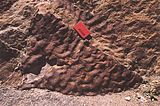
Ripple marks in Cretaceous Dakota Formation, east side of Dinosaur Ridge. Scale bar on notebook is 10 cm.
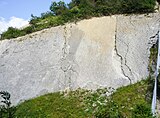
Ripple beds in the Wren's Nest National Nature Reserve, Dudley, England
Wave/symmetrical ripple, Nomgon, Mongolia
Cross-section through asymmetric climbing ripples, seen in the Zanskar Gorge, Ladakh, NW Indian Himalaya. Ripples climb when sediment fluxes in the flow are very high.
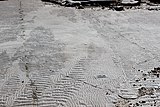
Complex ripple marks on Cambrian tidal flat at Blackberry Hill, Wisconsin.
See also[]
- Capillary wave
- Giant current ripples
- Hertha Ayrton - pioneer in description of how ripples formed
- Water on Mars - sedimentary ripple marks show indirect evidence of ancient water flows on our neighbor planet
- Transverse aeolian ridges - mysterious fossilized features on Mars that resemble giant ripples
- Washboarding - ripples on dirt roads formed by the interaction of vehicle wheels with the gravel and sediment
References[]
- Easterbrook, Don J. Surface processes and landforms. Upper Saddle River, N.J: Prentice Hall, 1999. Print. ISBN 0-13-860958-6 pp. 479-480.
- Greeley, Ronald, and James D. Iversen. Wind as a Geological Process On Earth, Mars, Venus and Titan (Cambridge Planetary Science Old). New York: Cambridge UP, 1987. ISBN 0-521-35962-7 pp. 153-154
- Monroe, James S., and Reed Wicander. The Changing Earth: Exploring Geology and Evolution, 2nd ed. Belmont: West Publishing Company, 1997. ISBN 0-314-09577-2 pp. 114-15, 352.
- ^ Boggs Jr., Sam. (2006) Principles of Sedimentology and Stratigraphy, 4th ed.
- ^ Potter, Pettijohn. (1977) Paleocurrents and Basin Analysis
- ^ Nichols, Gary. (2009) Sedimentology and Stratigraphy, Wiley, ISBN 978-1405135924
- ^ Stow, Dorrik A.V., (2009) Sedimentary Rocks in the Field: A Color Guide, Academic Press, ISBN 978-0123694515
- ^ Hiscott, Richard N. (1982) Tidal deposits of the Lower Cambrian Random Formation, eastern Newfoundland: facies and paleoenvironments, Canadian Journal of Earth Sciences, 19(10), 2028-2042, https://doi.org/10.1139/e82-180
External links[]
| Wikimedia Commons has media related to Ripple marks. |
- Sedimentary structures
- Patterned grounds
